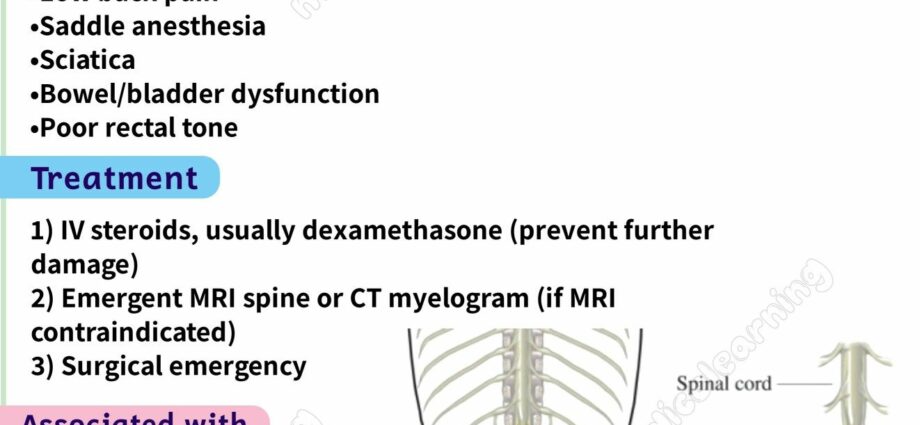Contents
Cauda equina syndrome
Cauda Equina Syndrome is damage to the nerve roots of the lower back. It is characterized by pain and the appearance of sensory, motor and genitosphincter disorders. This is a medical emergency that requires immediate treatment in order to avoid irreversible sequelae.
What is Cauda Equina Syndrome?
Definition of Cauda Equina Syndrome
Cauda Equina Syndrome is a group of disorders that occur when compressing nerve roots in the lower back. Emerging from the spinal cord at the level of the lumbar vertebrae, these nerve roots look like a ponytail. They innervate the organs of the pelvis and the lower limbs.
When the nerve roots are compressed, they can no longer fully play their role. Disorders in the pelvis and lower limbs appear. They usually appear bilaterally with some asymmetry. This means that it often affects both lower limbs, but the type and intensity of symptoms can be different on the left and right.
Causes of cauda equina syndrome
Cauda equina syndrome is caused by compression of the lumbar nerve roots. This has two major causes:
- a herniated disc, that is to say a protrusion of an intervertebral disc which will compress the nerves;
- a tumor that usually affects the nervous system.
The most common cause of cauda equina syndrome is a herniated disc. When it is due to a tumor, it can in particular be the consequence of an ependymoma. It is a malignant tumor that starts in the cells of the ependyma. It is none other than the membrane lining the cerebral ventricles and the central canal of the spinal cord.
In a few cases, cauda equina syndrome can be caused by spinal stenosis. It is a narrowing of the canal through which the nerve roots of the ponytail pass. Cauda equina syndrome can also sometimes be a complication of infectious spondylodiscitis, inflammation of one or more vertebrae and adjacent intervertebral discs.
Diagnosis of cauda equina syndrome
A clinical examination makes it possible to make a first diagnosis of cauda equina syndrome. It must be quickly confirmed by medical imaging examinations to allow emergency medical treatment. The diagnosis is usually validated by magnetic resonance imaging (MRI).
Cauda equina syndrome can occur at any age in both men and women. When it is secondary to a herniated disc, it often concerns men in their forties.
Symptoms of cauda equina syndrome
Cauda equina syndrome is manifested by the appearance of different disorders.
pain
Lower back pain appears. We usually talk about cruralgia (crural neuralgia) and sciatica (sciatic neuralgia, or more commonly sciatica), pain that extends from the pelvis to the lower limbs.
Lower back pain is frequently accompanied by pelvic and genital pain.
Sensory disorders
Paresthesia of the lower limbs is often observed. It is a non-painful sensory disorder that results in tingling, numbness and tingling sensations.
Motor disorders
Compression of the nerve roots of the ponytail induces motor disorders in the lower limbs. The latter can be more or less important, from the inability to extend the leg to paralysis of the lower limbs in the most severe cases.
Genitosphincter disorders
Compression of the nerve roots in the cauda equina can also affect the functioning of the urinary and anal sphincter system.
Several urinary disorders can occur: difficulty urinating such as urgent urination, urgent urge to urinate which can lead to incontinence.
At the anal level, constipation is more common than fecal incontinence.
Sexual activity can also be disrupted, including erectile dysfunction.
Treatments for cauda equina syndrome
As soon as it is diagnosed, cauda equina syndrome must be treated urgently.
Corticosteroid therapy may be offered to relieve pain. Neurosurgical intervention is usually organized to relieve the compression of the nerve roots. It is done:
- either by resection of the tumor or herniated disc;
- or by laminectomy, a technique that involves removing one or more vertebral blades.
The surgical operation is followed by functional rehabilitation.
In some cases, the treatment for cauda equina syndrome does not involve surgery. It is based on:
- antibiotic therapy for infectious causes;
- radiation therapy or chemotherapy when the tumor is inaccessible.
Prevent Cauda Equina Syndrome
Some causes of cauda equina syndrome can be prevented. In particular, the development of a herniated disc can be prevented by maintaining a healthy weight, a healthy lifestyle and good posture.
It is also recommended to be vigilant for the onset of symptoms of cauda equina syndrome. In the slightest doubt, an urgent medical consultation is recommended. This syndrome constitutes a diagnostic and therapeutic emergency to avoid irreversible sequelae.











Veľmi poučný článok.